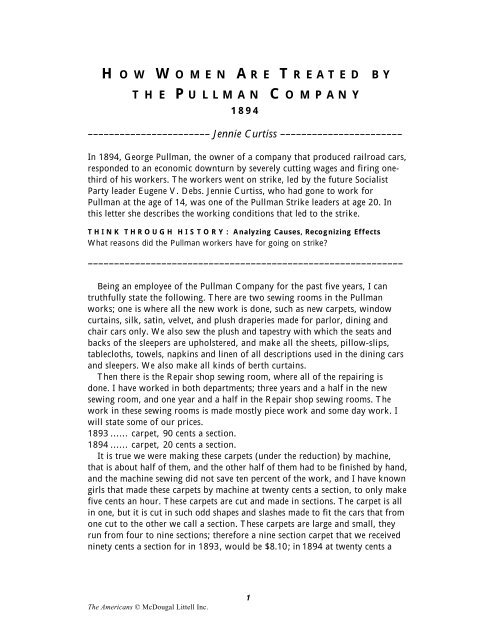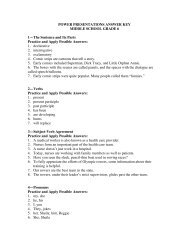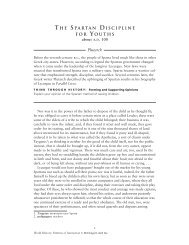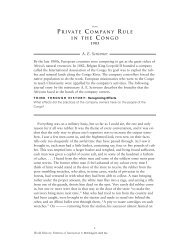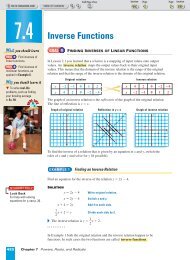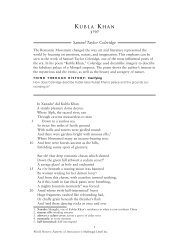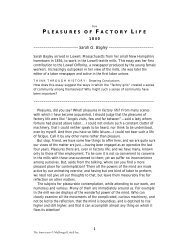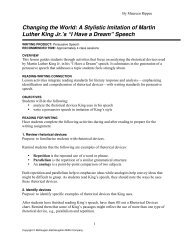How Women Are Treated by the Pullman Company - ClassZone
How Women Are Treated by the Pullman Company - ClassZone
How Women Are Treated by the Pullman Company - ClassZone
Create successful ePaper yourself
Turn your PDF publications into a flip-book with our unique Google optimized e-Paper software.
H O W W O M E N A R E T R E A T E D B Y<br />
T H E P U L L M A N C O M P A N Y<br />
The Americans © McDougal Littell Inc.<br />
1 8 9 4<br />
––––––––––––––––––––––– Jennie Curtiss –––––––––––––––––––––––<br />
In 1894, George <strong>Pullman</strong>, <strong>the</strong> owner of a company that produced railroad cars,<br />
responded to an economic downturn <strong>by</strong> severely cutting wages and firing onethird<br />
of his workers. The workers went on strike, led <strong>by</strong> <strong>the</strong> future Socialist<br />
Party leader Eugene V. Debs. Jennie Curtiss, who had gone to work for<br />
<strong>Pullman</strong> at <strong>the</strong> age of 14, was one of <strong>the</strong> <strong>Pullman</strong> Strike leaders at age 20. In<br />
this letter she describes <strong>the</strong> working conditions that led to <strong>the</strong> strike.<br />
T H I N K T H R O U G H H I S T O R Y : Analyzing Causes, Recognizing Effects<br />
What reasons did <strong>the</strong> <strong>Pullman</strong> workers have for going on strike?<br />
––––––––––––––––––––––––––––––––––––––––––––––––––––––––––––<br />
Being an employee of <strong>the</strong> <strong>Pullman</strong> <strong>Company</strong> for <strong>the</strong> past five years, I can<br />
truthfully state <strong>the</strong> following. There are two sewing rooms in <strong>the</strong> <strong>Pullman</strong><br />
works; one is where all <strong>the</strong> new work is done, such as new carpets, window<br />
curtains, silk, satin, velvet, and plush draperies made for parlor, dining and<br />
chair cars only. We also sew <strong>the</strong> plush and tapestry with which <strong>the</strong> seats and<br />
backs of <strong>the</strong> sleepers are upholstered, and make all <strong>the</strong> sheets, pillow-slips,<br />
tablecloths, towels, napkins and linen of all descriptions used in <strong>the</strong> dining cars<br />
and sleepers. We also make all kinds of berth curtains.<br />
Then <strong>the</strong>re is <strong>the</strong> Repair shop sewing room, where all of <strong>the</strong> repairing is<br />
done. I have worked in both departments; three years and a half in <strong>the</strong> new<br />
sewing room, and one year and a half in <strong>the</strong> Repair shop sewing rooms. The<br />
work in <strong>the</strong>se sewing rooms is made mostly piece work and some day work. I<br />
will state some of our prices.<br />
1893 ...... carpet, 90 cents a section.<br />
1894 ...... carpet, 20 cents a section.<br />
It is true we were making <strong>the</strong>se carpets (under <strong>the</strong> reduction) <strong>by</strong> machine,<br />
that is about half of <strong>the</strong>m, and <strong>the</strong> o<strong>the</strong>r half of <strong>the</strong>m had to be finished <strong>by</strong> hand,<br />
and <strong>the</strong> machine sewing did not save ten percent of <strong>the</strong> work, and I have known<br />
girls that made <strong>the</strong>se carpets <strong>by</strong> machine at twenty cents a section, to only make<br />
five cents an hour. These carpets are cut and made in sections. The carpet is all<br />
in one, but it is cut in such odd shapes and slashes made to fit <strong>the</strong> cars that from<br />
one cut to <strong>the</strong> o<strong>the</strong>r we call a section. These carpets are large and small, <strong>the</strong>y<br />
run from four to nine sections; <strong>the</strong>refore a nine section carpet that we received<br />
ninety cents a section for in 1893, would be $8.10; in 1894 at twenty cents a<br />
1
HOW W OMEN ARE TREATED BY THE PULLMAN COMPANY<br />
section, only $1.80. There have been a great many mistakes made about <strong>the</strong><br />
prices of <strong>the</strong>se carpets in <strong>the</strong> statements of <strong>the</strong> papers, and that is why I have<br />
tried to explain as much as possible in regard to <strong>the</strong>m.<br />
1893 A three window drapery $1.50<br />
1894 “ “ “ “ .80<br />
1893 A two window drapery 1.25<br />
1894 “ “ “ “ .48<br />
1893 A one window drapery 1.00<br />
1894 “ “ “ “ .45<br />
1893 1 enclosed section curtain .35<br />
1894 “ “ “ “ .15<br />
1893 1 mattress tick, folding (37 1-2) .40<br />
1894 1 “ “ “ .18<br />
1893 1 “ “ “ (27) .25<br />
1894 1 “ “ “ .10<br />
These prices are in <strong>the</strong> Repair shop sewing room, in which place I worked<br />
last. They get <strong>the</strong> same price for <strong>the</strong> same work in <strong>the</strong> new room, but <strong>the</strong> prices<br />
on <strong>the</strong> linen and several o<strong>the</strong>r things I can not give. There are numerous o<strong>the</strong>r<br />
kinds of work we make for <strong>the</strong> cars, which would take too much time and<br />
space to mention, which has all been cut from time to time to <strong>the</strong> very lowest<br />
standard. For four years we were allowed to make $2.25 a day at <strong>the</strong> prices of<br />
1893, which was very good wages for a girl, but which we well earned, as it<br />
was very tedious and confining, and long hours. At <strong>the</strong> time <strong>the</strong> shops closed on<br />
account of <strong>the</strong> strike, I was earning on an average eighty cents a day, at <strong>the</strong><br />
prices of 1894. It was very hard to have to work for such small wages as that,<br />
which would afford a person a mere existence. But <strong>the</strong> tyrannical and abusive<br />
treatment we received from our forewoman made our daily cares so much<br />
harder to bear. She was a woman who had sewed and lived among us for years,<br />
one, you would think, who would have some compassion on us when she was<br />
put in a position to do so. When she was put over us <strong>by</strong> <strong>the</strong> superintendent as<br />
our forewoman, she seemed to delight in showing her power in hurting <strong>the</strong> girls<br />
in every possible way. At times her conduct was almost unbearable. She was so<br />
abusive to certain girls that she disliked, that <strong>the</strong>y could not stand it, and would<br />
take <strong>the</strong>ir time and leave, who would o<strong>the</strong>rwise have been working <strong>the</strong>re today.<br />
If she could make you do a piece of work for twenty-five cents less than <strong>the</strong><br />
regular price, she would do so every time. In fact she cut a great deal of work<br />
down herself. I have had many a dispute with her myself about cutting down<br />
our prices just to get <strong>the</strong> work done cheaper, thinking she would stand in better<br />
with <strong>the</strong> <strong>Company</strong>. She was getting $2.25 a day and she did not care how much<br />
we girls made, whe<strong>the</strong>r we made enough to live on or not, just so long as she<br />
could figure to save a few dollars for <strong>the</strong> <strong>Company</strong>. When a girl was sick and<br />
asked to go home during <strong>the</strong> day, she would tell <strong>the</strong>m to <strong>the</strong>ir face <strong>the</strong>y were<br />
not sick, <strong>the</strong> cars had to be got out, and <strong>the</strong>y could not go home. She also had a<br />
The Americans © McDougal Littell Inc.<br />
2
HOW W OMEN ARE TREATED BY THE PULLMAN COMPANY<br />
few favorites in <strong>the</strong> room, to whom she gave all <strong>the</strong> best work, that <strong>the</strong>y could<br />
make <strong>the</strong> most money on. We would complain of her to <strong>the</strong> foreman and<br />
general foreman, but <strong>the</strong>y all upheld her, and if you were not willing to take her<br />
abuse you could go. There is now lying in Mr. Wickes’ office in Chicago a<br />
petition signed <strong>by</strong> fifteen girls in <strong>the</strong> sewing room, requesting her removal.<br />
There are only eighteen girls working under her. No doubt she will remain in<br />
<strong>the</strong> employ of <strong>the</strong> <strong>Pullman</strong> <strong>Company</strong>, as that is just <strong>the</strong> kind of people <strong>the</strong>y<br />
want at <strong>the</strong> heads of <strong>the</strong>ir departments—one who will help grind down <strong>the</strong>ir<br />
laborers. My fa<strong>the</strong>r worked for <strong>the</strong> <strong>Pullman</strong> <strong>Company</strong> for ten years. Last<br />
summer he was sick for three months, and in September he died. At <strong>the</strong> time of<br />
his death we owed <strong>the</strong> <strong>Pullman</strong> <strong>Company</strong> about sixty dollars for rent. I was<br />
working at <strong>the</strong> time and <strong>the</strong>y told me I would have to pay that rent, give what I<br />
could every pay-day, until it was paid. I did not say I would not pay, but thought<br />
ra<strong>the</strong>r than be thrown out of work I would pay it. Many a time I have drawn<br />
nine and ten dollars for two weeks’ work, paid seven dollars for my board and<br />
given <strong>the</strong> <strong>Company</strong> <strong>the</strong> remaining two or three dollars on <strong>the</strong> rent, and I still<br />
owe <strong>the</strong>m fifteen dollars. Sometimes when I could not possibly give <strong>the</strong>m<br />
anything, I would receive slurs and insults from <strong>the</strong> clerks in <strong>the</strong> bank, because<br />
Mr. <strong>Pullman</strong> would not give me enough in return for my hard labor to pay <strong>the</strong><br />
rent for one of his houses and live.<br />
JENNIE CURTISS<br />
Source: The <strong>Pullman</strong> Strike, edited <strong>by</strong> Leon Stein (New York: Arno Press,<br />
1969), pp. 75–78.<br />
The Americans © McDougal Littell Inc.<br />
3


